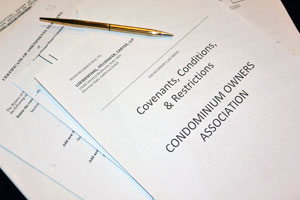LHC Newsletter Vol. 3, No. 3
Announcements:
Robert D. Hillshafer, Esq. has been selected to serve as a settlement officer to the newly established Voluntary Settlement Program of the Los Angeles Superior Court. This program implements a settlement conference resource utilizing a plaintiff attorney/defense attorney co-settlement process.
David A. Loewenthal, Esq. has been selected to serve on the California Association of Community Managers’ (CACM) legal steering committee and will participate in development of legal seminar curriculum and communications.
“Understanding New Fannie Mae/Freddie Mac Lending”
Requirements for Condominium Projects
By Robert D. Hillshafer, Esq. and David A. Loewenthal, Esq.
With varying deadlines which began 01/15/2009, new rules regarding loans for condominium purchases, transfers, etc. were implemented by Fannie Mae and Freddie Mac – Two government-sponsored enterprises (GSE’s) chartered by Congress with a mission to provide liquidity and stability to the U.S. housing and mortgage markets. These new rules have far ranging implications for associations of all descriptions. This article will provide a basic outline of the new rules. A PDF link to the Fannie Mae Announcement (No. 08-34 dated 12/16/08) is provided here:
https://www.efanniemae.com/sf/guides/ssg/annltrs/pdf/2008/0834.pdf
These new requirements underscore an association’s responsibilities for vigilance relative to compliance and, disclosure to and regular communication with members of any changes made and actions taken by the association to adjust to or comply with the new rules.
General Policy Changes Regarding Project Eligibility Requirements:
New/Converted Projects
In newly constructed/converted condominiums, the pre-sale eligibility requirement for Fannie Mae acceptance of home loans will increase from 51% to 70%, with “Bona fide contract for purchase to principal residence or second home purchasers.” While development has slowed greatly due to present economic conditions, this particular element of the new requirements may slow development and/or sales further of the “second home” market in areas throughout the region.
One interpretation of this new rule would be that 70% of a new association’s units would need to be pre-sold in order for Fannie Mae to consider the larger association as compliant. Our inquiries to Fannie Mae did not get results. Moreover, it may take some time for Fannie Mae and Freddie Mac staff and management to provide clear guidance on such new rules.
Delinquent HOA Dues for Units in Attached Condominium Projects
For both new and established attached condominium projects, no more than 15% of the total units in a project can be 30 days or more past due on the payment of condominium/ association fees. Given the increases regionally in the levels of delinquency within associations; this requirement will make it even more important that associations, boards of directors and managers keep extremely close track of fee and assessment payments and move promptly to resolve delinquencies. Failure to do so could result in delays and other obstructions to sales transactions on units within the association.
Fidelity Insurance for Units in Attached Condominium Projects*
Fannie Mae will now require fidelity bond/fidelity insurance for new and established condo projects with more than 20 units, with no exceptions. Clearly, any sale/purchase transactions will cause the association and boards to be able to demonstrate/document such coverage. Moreover, if the board has made changes to coverages for any reason; all members should be informed and/or reminded that such changes were made via standard communications processes.
* “Attached” is a term used frequently by Fannie Mae interchangeably with multi-unit condominium terminology in order to distinguish such units from free-standing PUD type structures.
Hazard Insurance for Units in Attached Condominium Projects, Including 2 – 4 Unit Projects
The new Fannie Mae policies require that a borrower purchase a “walls-in” coverage policy (i.e.: HO-6 policy) unless the lender can document that the association’s master policy provides that level of unit coverage. Also, the association’s master policy must include “replacement of improvements and betterment coverage” for improvements that the borrower/homeowner may have made to the units. Plus, that coverage must be in an amount “no less than 20 percent of the condominium unit’s appraised value.” If this type of coverage is unavailable, the association must contact the Fannie Mae Project Standards Department (202-752- 2916)*. The standard for a 5% deductible still applies.
Lenders must review the entire condominium project insurance policy to ensure that the HOA maintains a master blanket type of insurance for the project in which the borrower’s unit will be financed. Prohibited are: A blanket policy that covers unaffiliated associations or projects; self- insured associations and; group insurance of multiple associations.
Additionally, the association insurance must cover 100% of the insurable replacement cost of improvements, including the individual units’ in the association. Land, foundations, excavations and other elements are not ordinarily covered by insurance.
*NOTE: In performing the research for this newsletter, we contacted Fannie Mae several times and observed that their staff is not yet fully conversant on many of these requirements.
Cooperative Project Commercial Space and IRS Code Section 216
Income from commercial space (RE: The Selling Guide, Part X11, Section 501.02) was limited to 20% of its total income. The new policy eliminates that restriction but limits “non- residential use” to no more than 20 percent of the total square footage of the association.
Review of the Condominium Project’s Legal Documents
Previously, lenders were required to represent and warrant that the association’s legal documents comply with the prevailing law. The new policy eliminates this representation and warrant requirement altogether for condominium projects and “established and new” two-to-four unit projects.
New Condominium Projects (excluding two-to-four unit projects)
The new policies make the attorney review requirement optional for all review processes. However, lenders must “represent and warrant” that the association’s legal documents are in compliance with Fannie Mae’s legal requirements. Given the recent history of lending activities related to all real estate, associations, boards, and managers should pay extremely close attention to keeping association legal documents current and compliant.
Additional Ineligible Projects
New projects where the seller is offering loans/financing in excess of Fannie Mae’s individual loan eligibility standards, including but not limited to: builder/developer contributions, sales concessions, HOA or principal and interest payment abatements or any other incentives not properly disclosed (HUD-1 Settlement Statement) are prohibited. Also prohibited are:
- Projects with more than 20% non-residential space use.
- Projects where a single entity (individual, investor group, partnership or corporation) owns more than 10% of the total units in the project. This is meant to prevent speculators from dominating an association and/or unduly influencing price and/or manipulating value.
Owner-Occupancy Ratio Requirements
Established projects consisting of attached units must have an owner- occupancy ratio of at least 51% at the time a unit is purchased or refinanced. Given current foreclosure rates, lenders may represent significant ownership within some associations. Fannie Mae’s new policies address this by stating that if a unit is unrented and for sale by the lender or their agent, those units are considered to be owner-occupied for the purpose of calculating the ratio. If an association does not meet the 51% owner-occupancy requirement; any loans will be eligible only if the lender submits the project to Fannie Mae for review and approval for waiver on a single loan basis.
Conclusion
The full impact of these new lending requirements will take time to be fully understood. These changes also reinforce the need for associations, their boards and managers to be thorough and collaborative in ensuring compliance efforts. Regular review and adjustment of governing documents will be a key part of the compliance process. Ongoing regular communication of such activities and adjustments to association members remains critical.
© 2009 by Loewenthal, Hillshafer & Carter, LLP. All rights reserved. Permission is granted to reproduce or transmit in any form any part of this newsletter as long as proper attribution to Loewenthal, Hillshafer & Carter, LLP is given. Due to the rapidly changing nature of the law, information contained in this publication may become outdated. As a result, lawyers and all others using this material must research original sources of authority.


